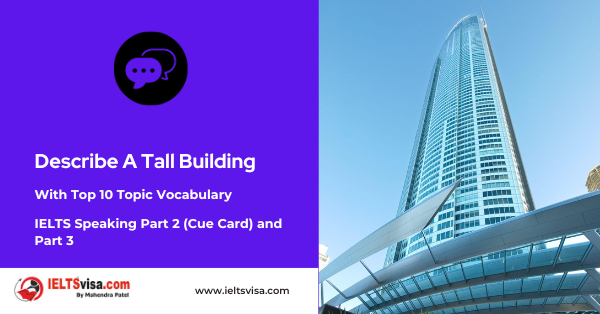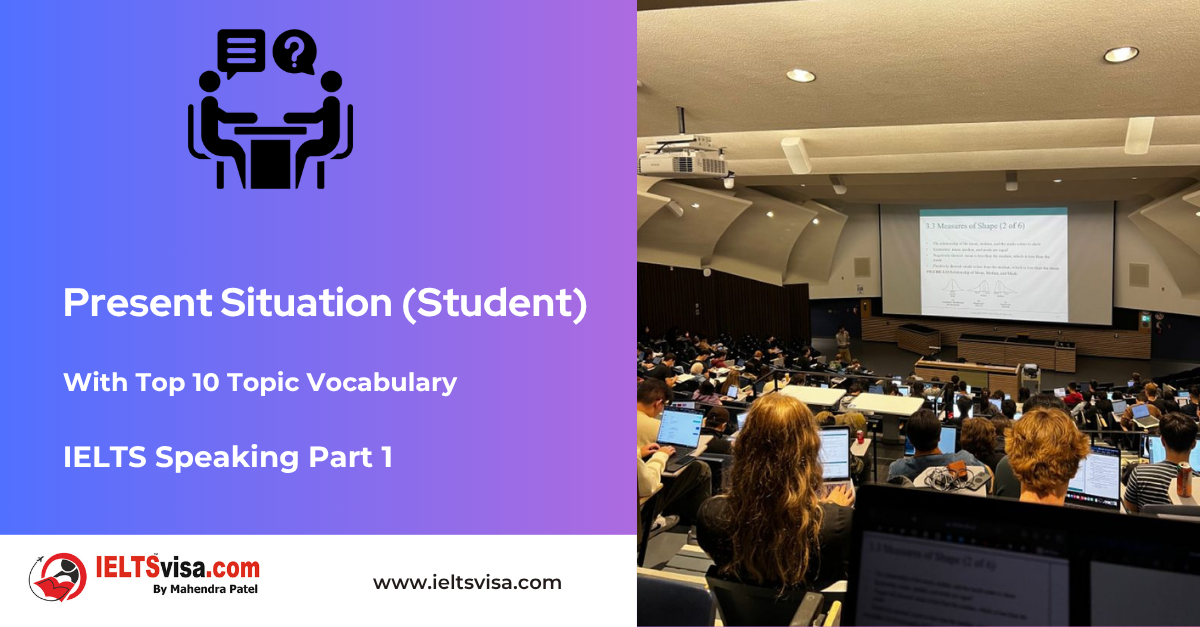A Tall Building
IELTS Speaking Part 2 (Cue Card) Part 3: Follow-Up Questions
A Tall Building
🗂️ Part 2 – Cue Card
Describe a tall building in your city or one that you have seen.
You should say:
- Where the building is
- What it is used for
- What it looks like
And explain what you like or dislike about it.
🗣️ Sample Answer
One tall building that really impressed me is the Q1 Tower located in the city of Gold Coast, Australia. I had the chance to visit it last year during a family holiday. It’s the tallest building in Australia and was once the tallest residential building in the world. From a distance, it looks like a shiny needle piercing the sky, with its modern glass design and sleek, curved architecture.
The building serves multiple purposes. It features luxurious residential apartments, a hotel, and a sky observation deck called SkyPoint. Tourists can take an elevator to the top floor to enjoy a 360-degree view of the ocean, city skyline, and surrounding countryside. The ride itself is super fast—it takes less than a minute to reach the top. When I stood at the observation deck, I felt both amazed and slightly nervous looking down at the tiny cars and people below.
What I liked most about the Q1 Tower was the combination of engineering and beauty. It’s not just tall—it’s also elegant and well-designed. However, I do feel a little uncomfortable with such heights, so I would not want to live there permanently. Still, as a visitor, it was a thrilling experience and one I would recommend to anyone visiting the Gold Coast.
🔁 Part 3: Follow-Up Questions
1. What types of buildings are popular in your country?
In my country, residential apartments, shopping malls, and office buildings are quite popular. In big cities, high-rise buildings are common due to limited land space. In smaller towns, low-rise houses are more common.
2. Why do people like living in tall buildings?
Many enjoy the scenic views and the peacefulness of being above street-level noise. Tall buildings also offer amenities such as gyms, pools, and enhanced security. Additionally, they help solve housing shortages in crowded cities.
3. Are there any disadvantages to living in a tall building?
Yes, high-rise living can lead to feelings of isolation. Elevators may become crowded, and during emergencies, evacuation can be difficult. Additionally, strong winds and high altitudes can make some people feel uneasy.
4. Do you think tall buildings are practical in all cities?
Not always. In cities with earthquake risks or poor infrastructure, tall buildings may not be suitable. Also, in heritage areas, tall structures might ruin the traditional skyline. Urban planning is important before construction.
5. How do tall buildings impact the environment?
Tall buildings can reduce urban sprawl by saving space. However, their construction and maintenance require a lot of resources and energy. Eco-friendly designs are becoming increasingly important in reducing their impact.
6. Why do cities build skyscrapers?
Skyscrapers help maximise land use in cities where land is scarce or expensive. They also serve as landmarks and symbols of economic growth. Businesses prefer them for prestige and convenience.
7. What role do architects play in designing tall buildings?
Architects ensure that the structure is not only tall but also safe, functional, and beautiful. They balance design with engineering requirements. Their creativity shapes the city’s skyline.
8. What are some famous tall buildings in the world?
Some famous ones include Burj Khalifa in Dubai, Shanghai Tower in China, and the Empire State Building in New York. These buildings are architectural marvels and attract millions of tourists.
9. Is it better to live in a tall building or a house?
It depends on personal preference. Tall buildings offer convenience and views, while houses offer privacy and space. Some prefer a quiet neighbourhood, while others enjoy city life from a higher vantage point.
10. Do you think tall buildings will become more common in the future?
Yes, especially in rapidly growing cities. As population increases and land becomes limited, vertical living will be a necessity. Future buildings may also become more sustainable and incorporate smart technology.
Top 10 Topic Vocabulary – A Tall Building
|
Vocabulary |
Type |
Meaning |
Synonyms |
Antonyms |
Word Family |
Example Sentence |
|
Skyscraper |
Noun |
A very tall building with many floors |
Tower, high-rise |
Hut, cottage |
— |
The skyscraper could be seen from miles away. |
|
Observation deck |
Noun |
A high platform for viewing the surroundings |
Viewing platform |
— |
Observe, observation |
I stood on the observation deck and saw the entire city. |
|
Architecture |
Noun |
The design and style of a building |
Structure, design |
Demolition |
Architect, architectural |
The building’s architecture is both modern and elegant. |
|
Luxurious |
Adj |
Very comfortable and expensive |
Fancy, opulent |
Simple, cheap |
Luxury |
The apartments in the building are luxurious and modern. |
|
Elevate |
Verb |
To lift up or raise to a higher position |
Lift, raise |
Lower |
Elevator, elevated |
The elevator elevates you to the top in under a minute. |
|
Skyline |
Noun |
The outline of buildings against the sky |
Horizon, silhouette |
— |
— |
The building adds beauty to the city skyline. |
|
Engineering |
Noun |
The science of building things like roads and towers |
Construction, design |
Destruction |
Engineer, engineered |
Its impressive height shows great engineering skills. |
|
Heritage |
Noun |
Valuable cultural traditions and history |
Legacy, tradition |
Modernity |
Hereditary |
Tall buildings should not damage the local heritage. |
|
Sustainable |
Adj |
Eco-friendly and able to last long term |
Green, renewable |
Harmful, wasteful |
Sustain, sustainability |
The design of future buildings should be sustainable. |
|
Infrastructure |
Noun |
The basic facilities and systems a city needs |
Framework, foundation |
Disrepair |
Infrastructural |
Tall buildings require strong infrastructure to support them. |

Our Books
Master IELTS Speaking Part 1
IELTS Writing Task 1 Book
IELTS Writing Task 2 Book
Practice IELTS Other Modules
IELTS Listening
The IELTS Listening test assesses how well you can understand spoken English in various contexts. It lasts about 30 minutes and is divided into four sections with a total of 40 questions. The listening tasks become increasingly difficult as the test progresses.
IELTS Academic Reading
The IELTS Academic Reading section assesses your ability to understand and interpret a variety of texts in academic settings. It is designed to evaluate a range of reading skills, including skimming for gist, reading for main ideas, reading for detail, understanding inferences, and recognizing a writer's opinions and arguments.
IELTS Speaking
The IELTS Speaking test assesses your ability to communicate in English on everyday topics. It lasts 11-14 minutes and consists of three parts: introduction, cue card, and a discussion based on the cue card topic.
IELTS General Reading
IELTS General Reading tests your ability to understand and interpret various types of texts. Here are some key areas and types of content you can expect to encounter in the reading section, along with tips for effective preparation.
IELTS Academic Writing Task 1
In IELTS Academic Writing Task 1, you are presented with a visual representation of information, such as graphs, charts, tables, or diagrams, and you are required to summarize, compare, or explain the data in your own words.
IELTS General Writing Task 1
In IELTS General Writing Task 1, you are required to write a letter based on a given situation. The letter can be formal, semi-formal, or informal, depending on the prompt. Here’s a breakdown of the key components to include in your letter
IELTS Academic Writing Task 2
In IELTS Academic Writing Task 2, you are required to write an essay in response to a question or topic. Here’s a guide to help you understand the essential elements of this task
IELTS Exam Tips
To succeed in the IELTS exam, practice regularly, familiarize yourself with the test format, improve your vocabulary, develop time management skills, and take mock tests to build confidence.
Grammer for IELTS
Grammar is the foundation of effective communication in English. Understanding tense usage, subject-verb agreement, and sentence structure enhances clarity and coherence in writing and speaking.
Vocabulary for IELTS
Vocabulary plays a crucial role in the IELTS (International English Language Testing System) exam, especially in the Speaking and Writing sections. Here’s an overview of why vocabulary is important and how it impacts your performance
RECENT IELTS SAMPLES QUESTIONS AND ANSWERS
IELTS Speaking Part 1 – Favourite Sujbect – Physics
IELTS Speaking Part 1 - Favourite Sujbect - Physics Q: What is your favourite subject? A: My favourite subject...
IELTS Speaking Part 1 – Present Situation (Student)
IELTS Speaking Part 1 - Present Situation (Student) Q1: Are you a student or do you work?A: I’m a full-time...
IELTS Speaking Part 1 – Present Situation – Employee – as an International Student and Social Worker
IELTS Speaking Part 1 - Present Situation - Employee - as an International Student and Social Worker Q1: Are...
IELTS Speaking Part 1 – Persent Situation – Employee- as an Electric Engineer
IELTS Speaking Part 1 - Persent Situation - Employee- as an Electric Engineer Q1: What do you do for a...
IELTS Speaking Part 1 – Persent Situation – Employee – as an Software Engineer
IELTS Speaking Part 1 - Persent Situation - Employee - as an Software Engineer Q1: What do you do for a...
IELTS Speaking Part 1 – Persent Situation – Married
IELTS Speaking Part 1 - Persent Situation - Married Q1: Are you married?A: Yes, I am married. My spouse and I...













